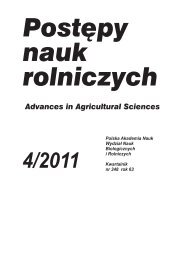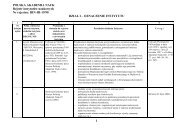78 E. Cieœlik, A. Siembida[26] Karczmarewicz E., Skorupa E., Lorenc S.R. 2002. Wp³yw probiotyków i prebiotyków na gospodarkê wapniowo-fosforanow¹i metabolizm kostny. Ped. Wspó³., Hepat. i ¯yw. Dziecka 4(1): 63–69.[27] Kawakami A., Yoshida M. 2005. Fructan: fructan 1-fructosyltransferase, a key enzyme for biosynthesis ofgraminan oligomers in hardened wheat. Planta 223: 90–104.[28] Kleessen B., Hartmann L., Blaut M. 2001. Oligofructose and long-chain inulin: influence on the gut microbialecology of rats associated with a human faecal flora. Br. J. Nutr. 86 (2): 291–300.[29] Knudsen K.E.B. 1997. Carbohydrate and lignin contents of plant materials used in animal feeding. Anim. FeedSci. Technol. 67: 319–338.[30] Kolida S., Gibson G.R. 2007. Prebiotic capacity of inulin-type fructans. J. Nutr. 137: 2503–2506.[31] Kubik C., Piasecka K., Anyszka A., Bielecki S. 2006. Polifruktany i fruktooligosacharydy (FOS) – wystêpowanie,otrzymywanie i zastosowanie. Biotech. 2(73): 103–116.[32] Livingston III DP, Knievel D.P., Gildow F.E. 1994. Fructan synthesis in oat. 1. Oligomer accumulation in stemsduring cold hardening and their in vitro synthesis in a crude enzyme extract. New Phytol. 127: 27–36.[33] Livingston D., Premakumar R., Tallury S.P. 2005. Carbohydrate concentrations in crown fractions from winteroat during hardening at sub-zero temperatures. Ann. Bot. 96: 331–335.[34] López M.G., Mancilla-Margalli N.A., Mendoza-Diaz G. 2003. Molecular structures of fructans from Agavetequilana WEBER var. azul. J. Agric. Food Chem. 51(27): 7835–7840.[35] Mancilla-Margalli N.A., López M.G. 2006. Water-soluble carbohydrates and fructan structure patterns fromAgave and Dasylirion species. J. Agric. Food Chem. 54: 7832–7839.[36] McCallum J., Clarke A., Pither-Joyce M. 2006. Genetic mapping of a major gene affecting onion bulb fructancontent. Theor. Appl. Genet. 112: 958–967.[37] Merendino N., D’Aquino M., Molinari R., De Gara L., Grazia M. D’Egidio, Paradiso A., Cecchini C., CorradiniC., Tomassi G. 2006. Chemical characterization and biological effects of immature durum wheat in rats. J.Cereal Sci. 43: 129–136.[38] Nagaraj V.J., Riedl R., Boller T., Wiemken A., Meyer A.D. 2001. Light and sugar regulation of the barleysucrose : fructan 6-fructosyltransferase promoter. J. Plant Physiol. 158: 1601–1607.[39] O’Donoghue E.M., Somerfield S.D., Shaw M., Bendall M., Hedderly D., Eason J. 2004. Evaluation ofcarbohydrates in Pukekohe Longkeeper and Grano cultivars of Allium cepa. J. Agric. Food Chem., 52:5383–5390.[40] Paradiso A., Cecchini C., de Pinto M.C., De Gara L., D’Egidio M.G. 2003. Fructans and vitamin C contents inimmature and mature kernels of Triticum durum and their wholemeal. Proceedings of Second InternationalWorkshop ‘Durum Wheat and Pasta Quality, Recent Achievements and New Trends’: 219–221.[41] Pozzo A.M.C., Abrameto M., Pellejero G., Aschkar G., Gil M.I., Van Konijnemburg A. 2005 Efecto del períodode conservación sobre algunas propiedades nutracéuticas y organolépticas en los bulbos de cultivares nacionalesde cebollas (Allium cepa L.) en el valle inferior de Río Negro. Revista Investigaciones Agropecuarias 34:115–130.[42] Praznik, W., Huber, A., and Cieœlik, E. 2004. Fructans: occurrence and applications in food. Chemical andFunctional Properties of Food Saccharides. CRS Press LLC, the USA.[43] Ravenscroft N., Cescutti P., Hearshaw M.A., Ramsout R., Rizzo R., Timme E.M. 2009. Structural analysis offructans from Agave americana grown in South Africa for spirit production. J. Agric. Food Chem. 57(10):3995–4003.[44] Reveal J.L. 1999. System of Classification, Plant Taxonomy, Department of Plant Biology. University ofMaryland.[45] Ritsema T., Smeekens S. 2003. Fructans: beneficial for plants and humans. Curr. Opin. Plant Biol. 6: 223–230.[46] Roberfroid M.B., Slavin J. 2000. Nondigestible oligosaccharides. Crit. Rev. Food Sci. Nutr. 40: 461–480.[47] Roberfroid M.B. 2000. Chicory fructooligosaccharides and the gastrointestinal tract. Nutrition 16(7/8):677–679.[48] Roberfroid M.B. 2007. Inulin-type fructans: Functional food ingredients. J. Nutr. 137: 2493–2502.[49] Rodrígues A.S., Fogliano V., Graziani G., Mendes S., Vale A.P., Gonçalves C. 2003. Nutritional value of onionregional varieties in Northwest Portugal. Elec. J. Environ. Agric. Food Chem. 2: 519–524.[50] Singh R.S., Dhaliwal Rajesh, Puri Munish 2006. Production of inulinase from Kluyveromyces marxianus YS-1using root extract of Asparagus racemosus. Proc. Bioch. 41: 1703–1707.[51] Shiomi N. 1979. Isolation and identification of 1-kestose and neokestose from onion bulbs (Allium cepa).J. Faculty Agric. Hokkaido Uni. 58: 548–556.
Fruktany i ich wystêpowanie … 79[52] Shiomi N. 1992. Content of carbohydrate and activities of fructosylotransferase and invertase in asparagus rootsduring the frukctooligosaccharide- and fructopolysaccharide accumulating season. New Phytol. 122: 421–432.[53] Thakur M., Bhargava S., Dixit V.K. 2009. Effect of Asparagus racemosus on sexual dysfunction inhyperglycemic male rats. Pharmaceut. Biol. 47(5): 390–395.[54] Trafalska E., Grzybowska K. 2004. Probiotyki – alternatywa dla antybiotyków? Wiad. Lek. 57(9–10).[55] Trunova T.L. 1965. Light and temperature systems in the hardening of winter wheat and the significance ofoligosaccharides for frost resistance. Fiziol. Rast. 12: 70–77.[56] Van Loo J., Coussement P., de Leenheer L., Hoebregs H., Smits G. 1995. On the presence of inulin andoligofructose as natural ingredients in the western diet. Crit. Rev. Food Sci. Nutr. 35: 525–552.[57] Van Loo J. 2007. How chicory fructans contribute to zootechnical performance and well-being in livestock andcompanion Animals. J. Nutr. 137: 2594–2597.[58] Venter C.S. 2007. Prebiotics: an update. JFECS 35: 17–25.[59] Visavadiya N.P., Narasimhacharya R.L. 2005. Hypolipidemic and antioxidant activities of Asparagus racemosusin hypercholesteremic rats. Indian J. Pharm. Sci. 37(6): 376–380.[60] Wagner W., Keller F., Wiemken A. 1983. Fructan metabolism in cereals: induction in leaves and compartmentationin protoplasts and vacuoles. Z Pflanz. 112: 359–372.[61] Waleckx E., Gschaedler A., Colonna-Ceccaldi B., Monsun P. 2008. Hydrolysis of fructans from Agave tequilanaWEBER var. azul during the cooking step in a traditional tequila elaboration process. Food Chem. 108: 40–48.[62] Wang C., Tillberg J.E. 1996. Effects of nitrogen deficiency on accumulation of fructan and fructan metabolizingenzyme activities in sink and source leaves of barley (Hordeum vulgare). Physiol. Plant. 97: 339–345.[63] Wang C., Tillberg J.E. 1997. Effects of short-term phosphorus deficiency on carbohydrate storage in sink andsource leaves of (Hordeum vulgare). New Phytol. 136: 131–135.[64] Wang N., Nobel P.S. 1998. Phloem transport of fructans in the crassulacean acid metabolism species Agavedeserti. Plant Physiol. 116: 709–714.[65] Yang J., Zhang J., Wang Z., Zhu Q., Liu L. 2004. Activities of fructan- and sucrose-metabolizing enzymes inwheat stems subjected to water stress during grain filling. Planta 220: 331–343.[66] Zaj¹c A., Mirek Z., Piêkoœ-Mirkowa H., Zaj¹c M. 2002. Flowering plants and pteridophytes of Poland:a checklist. Krytyczna lista roœlin naczyniowych Polski. Instytut Botaniki PAN im. W³adys³awa Szaferaw Krakowie, ISBN 83-85444-83-1.[67] Zamudio D.M., Pinos-Rodríguez J.M., González S.S., Robinson P.H., García J.C. and Montañez O. 2009.Effects of Agave salmiana OTTO ex SALM-DYCK silage as forage on ruminal fermentation and growth in goats.Anim. Feed Sci. Technol. 148: 1–11.Fructans and their occurrence in cultivated plantsKey words: fructans, chemical composition, characterization of their sourcesSummaryFructans, or polyfructosylsucroses, are water-soluble polymers of fructose buildupon a -D-fructofuranosyl units linked to each other by (2-1) and/or -(2,6) bonds,meanwhile a glucose moiety may be linked to the reducing end of the chain by an-(1->2) bond.Five different groups of fructans are found in the nature and can be distinguishedaccording to the type of linkage in structure and the position of glucose moiety. Thesegroups consist of inulins, neoseries inulins, levans (produced by bacteria)/phleins(produced by plants), neoseries levans, and the mixed fructans group (graminan).
- Page 1 and 2:
Postepy ˛naukrolniczychAdvances in
- Page 3 and 4:
Postêpy Nauk Rolniczych nr 4/2010:
- Page 5 and 6:
Profesor Jerzy Wa¿ny (1927-2010))
- Page 7 and 8:
Profesor Jerzy Wa¿ny (1927-2010))
- Page 9 and 10:
Postêpy Nauk Rolniczych nr 4/2010:
- Page 11 and 12:
Optymalizacja u¿ytkowania powierzc
- Page 13 and 14:
Optymalizacja u¿ytkowania powierzc
- Page 15 and 16:
Optymalizacja u¿ytkowania powierzc
- Page 17 and 18:
Optymalizacja u¿ytkowania powierzc
- Page 19 and 20:
Postêpy Nauk Rolniczych nr 4/2010:
- Page 21 and 22:
Oszczêdne gospodarowanie wod¹ …
- Page 23 and 24:
Oszczêdne gospodarowanie wod¹ …
- Page 25 and 26:
Oszczêdne gospodarowanie wod¹ …
- Page 27 and 28: Oszczêdne gospodarowanie wod¹ …
- Page 29 and 30: Oszczêdne gospodarowanie wod¹ …
- Page 31 and 32: Oszczêdne gospodarowanie wod¹ …
- Page 33 and 34: Postêpy Nauk Rolniczych nr 4/2010:
- Page 35 and 36: Substancje aktywne … 35ciach chê
- Page 37 and 38: Substancje aktywne … 37szkodliwym
- Page 39 and 40: Substancje aktywne … 39nieœli do
- Page 41: Substancje aktywne … 41Active sub
- Page 44 and 45: 44 J. Szumigaj-Tarnowska, Cz. Œlus
- Page 46 and 47: 46 J. Szumigaj-Tarnowska, Cz. Œlus
- Page 48 and 49: 48 J. Szumigaj-Tarnowska, Cz. Œlus
- Page 50 and 51: 50 J. Szumigaj-Tarnowska, Cz. Œlus
- Page 52 and 53: 52 J. Szumigaj-Tarnowska, Cz. Œlus
- Page 54 and 55: 54 J. Szumigaj-Tarnowska, Cz. Œlus
- Page 56 and 57: 56 E.U. Kozik, I. Ostrzy¿ek, W. Sz
- Page 58 and 59: 58 E.U. Kozik, I. Ostrzy¿ek, W. Sz
- Page 60 and 61: 60 E.U. Kozik, I. Ostrzy¿ek, W. Sz
- Page 62 and 63: 62 E.U. Kozik, I. Ostrzy¿ek, W. Sz
- Page 64 and 65: 64 E.U. Kozik, I. Ostrzy¿ek, W. Sz
- Page 67 and 68: Postêpy Nauk Rolniczych nr 4/2010:
- Page 69 and 70: Fruktany i ich wystêpowanie … 69
- Page 71 and 72: Fruktany i ich wystêpowanie … 71
- Page 73 and 74: Fruktany i ich wystêpowanie … 73
- Page 75 and 76: Fruktany i ich wystêpowanie … 75
- Page 77: Fruktany i ich wystêpowanie … 77
- Page 81 and 82: Postêpy Nauk Rolniczych nr 4/2010:
- Page 83 and 84: Wp³yw selenu … 83Rysunek 1. Wybr
- Page 85 and 86: Wp³yw selenu … 85nianych zwierz
- Page 87 and 88: Wp³yw selenu … 87[17]. Obni¿eni
- Page 89 and 90: Wp³yw selenu … 89[8] Estienne M.
- Page 91 and 92: Postêpy Nauk Rolniczych nr 4/2010:
- Page 93 and 94: Ekspresja genu GnRH … 93Ekspresja
- Page 95 and 96: Ekspresja genu GnRH … 95Wp³yw st
- Page 97 and 98: Ekspresja genu GnRH … 97Tabela 2.
- Page 99 and 100: Ekspresja genu GnRH … 99Zmniejsze
- Page 101 and 102: Ekspresja genu GnRH … 101Stwierdz
- Page 103 and 104: Ekspresja genu GnRH … 103[28] Li
- Page 105 and 106: Postêpy Nauk Rolniczych nr 4/2010:
- Page 107 and 108: Prawna ochrona odmian roœlin … 1
- Page 109 and 110: Prawna ochrona odmian roœlin … 1
- Page 111 and 112: Prawna ochrona odmian roœlin … 1
- Page 113 and 114: Prawna ochrona odmian roœlin … 1
- Page 115 and 116: Prawna ochrona odmian roœlin … 1
- Page 117 and 118: Prawna ochrona odmian roœlin … 1
- Page 119 and 120: Prawna ochrona odmian roœlin … 1
- Page 121 and 122: Postêpy Nauk Rolniczych nr 4/2010:
- Page 123 and 124: Biotesty w badaniach toksykologiczn
- Page 125 and 126: Biotesty w badaniach toksykologiczn
- Page 127 and 128: Biotesty w badaniach toksykologiczn
- Page 129 and 130:
Biotesty w badaniach toksykologiczn
- Page 131:
Biotesty w badaniach toksykologiczn
- Page 134:
ContentsProfessor Jerzy Wa¿ny (192
















